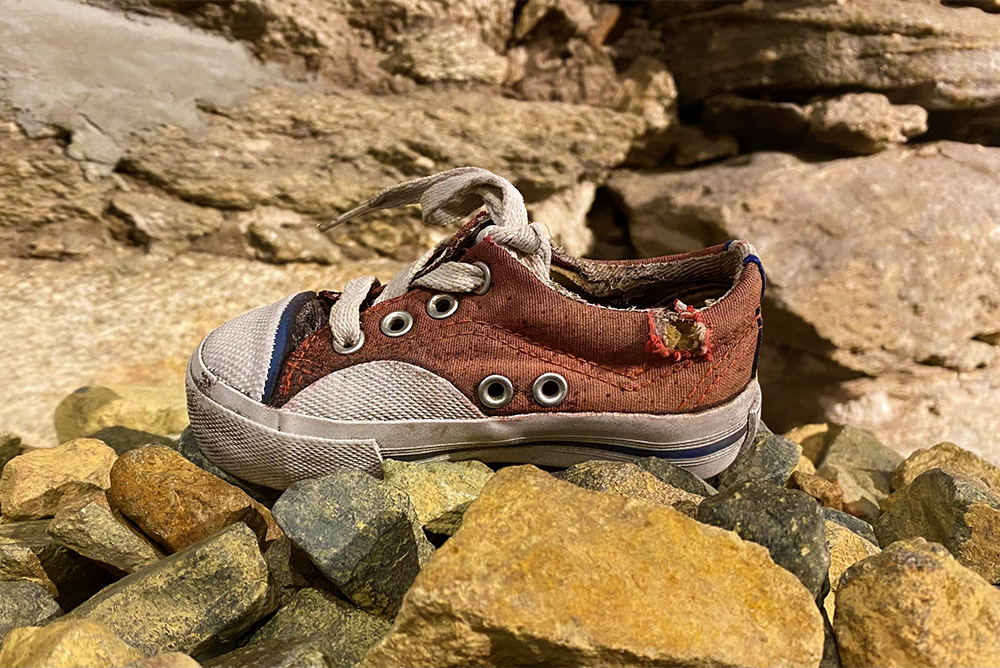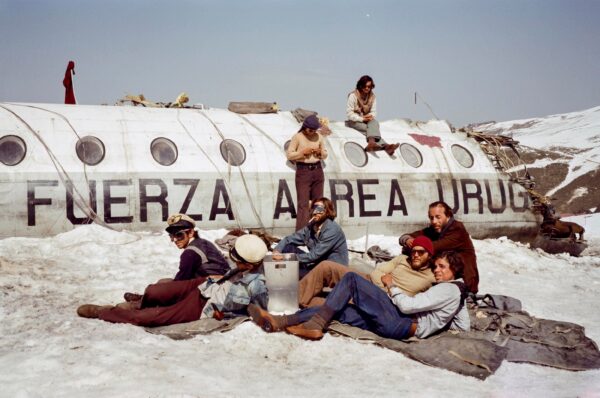
Oscar contender Society of the Snow tells the horrific story of the 1972 Uruguayan plane crash in the Andes. Journalist Kelly Candaele considers what the new film—and the real events it is based on—can tell us about suffering, death, God, and the elemental will to live. A small red shoe recovered from the plane wreckage. Courtesy of Andes Museum 1972. Mauro F. Montaño.
At the beginning of Society of the Snow, Spain’s entry for Best International Feature Film for the upcoming Academy Awards, there is a scene in a Catholic church in Montevideo, Uruguay, where a priest can be heard stating that “Man does not live by bread alone.”
It’s the first indication that the film, about the 1972 Uruguayan plane crash in the Andes, will be centered on the spiritual and explicitly religious dimension of the experience.
The story of the crash is, at this point, ingrained in the Uruguayan national memory: In October, 1972, a rugby team from Montevideo and their friends and family boarded a flight from Uruguay heading for a match in Chile. Severe weather in the Andes led the pilots to make a fatal mistake, clipping the top of a mountain and shearing off the plane’s wings and tail section, sending part of the fuselage sliding into a ravine. Of the 45 people who boarded the plane, only 16 survived 72 days in subfreezing temperatures before being rescued.
When the news broke in Uruguay that some passengers survived, reporters called what happened both “a tragedy and a miracle.” But after the survivors arrived safely in Chile, journalists started asking questions about how they lasted more than two months in the bleak environment without food. Papers in Chile and other countries blasted headlines of “cannibalism” across their front pages and printed stories insinuating that the “stronger” survivors overpowered and killed the weak, and that group solidarity had quickly devolved into selfishness and domination.
Only when the survivors made it home to Montevideo did one of them, Alfredo Delgado, finally address the accusations during a press conference. He framed it in religious terms. Amidst the silence of the mountains, he said, he and the others felt “the presence of God.” Making a direct analogy to the Catholic Eucharist, he continued, “If Jesus at his last supper had shared his flesh and blood with his apostles, then it was a sign to us that we should do the same—take the flesh and blood as an intimate communion between us all.”
According to journalist Piers Paul Read’s book Alive, which inspired an earlier 1993 movie about the crash, what followed was stark silence—and then spontaneous applause from the audience. Back home among their fellow countrymen, Delgado and the others could speak honestly.
I was in the old city of Montevideo the weekend Society of the Snow premiered there, and I spoke with a number of people who had seen the new film, which was playing throughout the city. I was curious about their response to a new representation of an incident that is so well-known to all Uruguayans.
“At the end of the movie, people in the theater were crying,” Maya Smeding, a student at the University of the Republic in Montevideo, told me. “Uruguay is a small country and one of the important messages of the film is that if we don’t come together as a people, we cannot accomplish what we need to do.”
Sandra Henry, a landscape designer from Montevideo, was 12 years old when the crash occurred. “When I saw this movie, I understood with my soul what went into the choice they made,” she said. “It was a human feeling that they needed to survive and return to their families.”
During my stay in Montevideo, I also visited the Museo Andes 1972, which is dedicated to the crash. Opened in 2013 and self-funded by Uruguayan businessman Jörg P.A. Thomsen, the nondescript museum is snuggled among the 19th and early 20th-century neo-classical and art-deco buildings that are common along the city’s narrow streets.
The Museo Andes 1972 exists for the survivors, but also to commemorate those who didn’t come home. “Some of those on the plane were rugby players,” said Thomsen, “but many were not. Many were Catholics, but others were not. Most were men, but Liliana Methol, who died in the avalanche, played a wonderful and important role.”
Thomsen told me that he wanted to document the story of what happened because it “says something positive about the Uruguayan national identity.”
In addition to the pictures, newspaper articles, and artifacts from the crash site held in the museum’s three floors are tools the survivors crafted out of the wreckage to survive. They turned shards of aluminum into water spouts to melt snow to drink and sewed cloth from the airplane seats into gloves and snow shoes. Insulation from the tail of the plane was sewn into a large sleeping bag that two of the men used on their ten-day trek over mountain peaks in search of help.
Their ingenuity, when menaced by the deadly cold, reminded me that there’s a connection between tool-making, survival, and the imagination. “To me,” Thomsen said, echoing Henry’s comment, “a key to their survival was knowing how their families would suffer if they did not return.”
Touring the museum, what seems to be left after more than 50 years is not condemnation or second-guessing of each other, which was common enough during their ordeal, but the solidarity and love that the survivors and those who died had demonstrated.
I finally watched Society of the Snow for myself when I returned home from Uruguay to Los Angeles. In the very first shot, the camera moves across a slate of vacant whiteness in the Andes, a suggestion that viewers, like the survivors, have the obligation to create our futures out of the emptiness that we will at times confront.
Uruguayan cinematographer Pedro Luque later told me he struggled with the fact that in a vast white landscape, visually determining distances was unreliable. “It was abstract because of the vastness of the landscape that entrapped them like a giant monster,” he said. “But at the same time, the whiteness allowed us to create striking compositions like Japanese calligraphy with simple but powerful visual strokes.”
If snow-bleached distances were abstract, living close to one another is what brought the survivors’ moral visions into focus, as they struggled to live after seeing their friends and relatives die.
Society of the Snow lingers on these spare moments, where survivors try to make sense of their extreme situation, and struggle to define what their values actually are, and how to make them real in their behavior toward one another.
In one of the scenes, Arturo Nogueira, who did not survive long enough to be rescued, explains that for him, God is not an abstraction but is present in the friends who try to keep him warm or bind his wounds.
I thought of a little red shoe in the museum that was brought back from the wreckage and donated. Purchased as a present for a relative’s newborn child, the survivors gave one shoe of the pair to anyone who was going on a dangerous search expedition with the idea that they would be sure to bring it back—a talisman of strength, memory, and return.
It’s still hard to imagine that this story took place, but it did. Society of the Snow’s director J.A. Bayona has spoken about it as a film about understanding that you and the other are the same, and about supporting one another for collective survival. He recently told the Buenos Aires Herald: “If you have the strongest legs you will walk for us, and if you need my body to survive, I will give it to you so you can return home.”
Biblical scholar John Dominic Crossan has written that if man does not live by bread alone, it is only because “bread is never alone.” The survivors of the 1972 crash have all asked themselves why they were spared, but also the unavoidable question of why the others were not. I think that Society of the Snow provides one among the many possible answers: They shared a faith in one another.





Send A Letter To the Editors